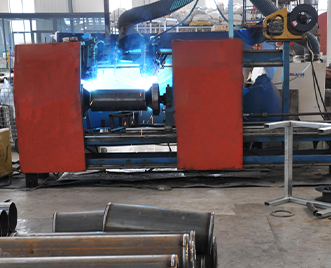Nov . 05, 2024 08:06 Back to list
electric submersible pumps
Electric Submersible Pumps An Overview
Electric submersible pumps (ESPs) are widely recognized for their efficiency and effectiveness in various liquid transportation applications. These pumps are designed to be submerged underwater, which allows them to operate efficiently in deep well environments, sewage systems, and other challenging conditions. This article provides insight into the working principle, applications, advantages, and maintenance considerations of electric submersible pumps.
Working Principle
Electric submersible pumps operate on a simple principle they utilize an electric motor to drive a series of impellers that move fluid from a lower elevation to a higher elevation. The motor is usually located at the bottom of the pump and is coupled directly with the pump's impellers. As the motor turns, it creates centrifugal force, which draws liquid into the pump and pushes it upwards through the discharge pipe.
The entire assembly is sealed in a housing that protects the components from water ingress, ensuring reliable operation even when submerged. Most modern ESPs also utilize a variable frequency drive (VFD), allowing for precise control over the pumping process, which improves operational efficiency and reduces energy consumption.
Applications
Electric submersible pumps are particularly versatile and are used across various industries, including
1. Oil and Gas Industry ESPs are extensively used in oil wells to lift crude oil to the surface. They are particularly useful in high-volume production and deep well applications, where conventional pumping methods may not be feasible.
2. Water Supply and Irrigation In agriculture, ESPs are employed to extract groundwater for irrigation purposes. They are also used for municipal water supply systems, delivering clean water from underground sources.
3. Sewage and Wastewater Management ESPs play a crucial role in sewage treatment plants, where they help pump wastewater and sludge, ensuring proper treatment and disposal.
4. Mining Operations In mining, these pumps are essential for dewatering operations, helping manage water levels in pits and preventing flooding.
Advantages
electric submersible pumps

The advantages of electric submersible pumps are numerous
- High Efficiency ESPs demonstrate high efficiency rates due to their ability to operate submerged, significantly reducing the energy required to lift water.
- Reliable Operation By being submerged, these pumps are less prone to cavitation and air binding, which can cause pump failure.
- Space-saving Design Since ESPs are compact and can be installed directly in wells or pits, they require minimal surface space
.- Reduced Noise Levels Being submerged in water minimizes operational noise, making ESPs suitable for residential or noise-sensitive areas.
Maintenance Considerations
While electric submersible pumps are designed for durability, they do require regular maintenance to ensure long-term reliability. Maintenance practices include
- Regular Inspections Checking for any signs of wear and tear, leaks, or corrosion in the pump and motor components.
- Motor Testing Monitoring the electric motor's performance and efficiency to prevent unexpected failures.
- Cleaning Ensuring that the pump intake is free from debris or blockages, which can hinder performance.
- Lubrication Regularly lubricating moving parts can enhance efficiency and extend the life of the pump.
In conclusion, electric submersible pumps are indispensable tools across various sectors, from water supply to oil extraction. Their efficient operation, compact design, and versatility make them a preferred choice for any application that requires the reliable transport of liquids. With proper maintenance, they can provide years of dependable service, proving their value within the industrial landscape.
-
Submersible Water Pump: The Efficient 'Power Pioneer' of the Underwater World
NewsJul.01,2025
-
Submersible Pond Pump: The Hidden Guardian of Water Landscape Ecology
NewsJul.01,2025
-
Stainless Well Pump: A Reliable and Durable Pumping Main Force
NewsJul.01,2025
-
Stainless Steel Submersible Pump: An Efficient and Versatile Tool for Underwater Operations
NewsJul.01,2025
-
Deep Well Submersible Pump: An Efficient 'Sucker' of Groundwater Sources
NewsJul.01,2025
-
Deep Water Well Pump: An Efficient 'Sucker' of Groundwater Sources
NewsJul.01,2025
-
 Submersible Water Pump: The Efficient 'Power Pioneer' of the Underwater WorldIn the field of hydraulic equipment, the Submersible Water Pump has become the core equipment for underwater operations and water resource transportation due to its unique design and excellent performance.Detail
Submersible Water Pump: The Efficient 'Power Pioneer' of the Underwater WorldIn the field of hydraulic equipment, the Submersible Water Pump has become the core equipment for underwater operations and water resource transportation due to its unique design and excellent performance.Detail -
 Submersible Pond Pump: The Hidden Guardian of Water Landscape EcologyIn courtyard landscapes, ecological ponds, and even small-scale water conservancy projects, there is a silent yet indispensable equipment - the Submersible Pond Pump.Detail
Submersible Pond Pump: The Hidden Guardian of Water Landscape EcologyIn courtyard landscapes, ecological ponds, and even small-scale water conservancy projects, there is a silent yet indispensable equipment - the Submersible Pond Pump.Detail -
 Stainless Well Pump: A Reliable and Durable Pumping Main ForceIn the field of water resource transportation, Stainless Well Pump has become the core equipment for various pumping scenarios with its excellent performance and reliable quality.Detail
Stainless Well Pump: A Reliable and Durable Pumping Main ForceIn the field of water resource transportation, Stainless Well Pump has become the core equipment for various pumping scenarios with its excellent performance and reliable quality.Detail
